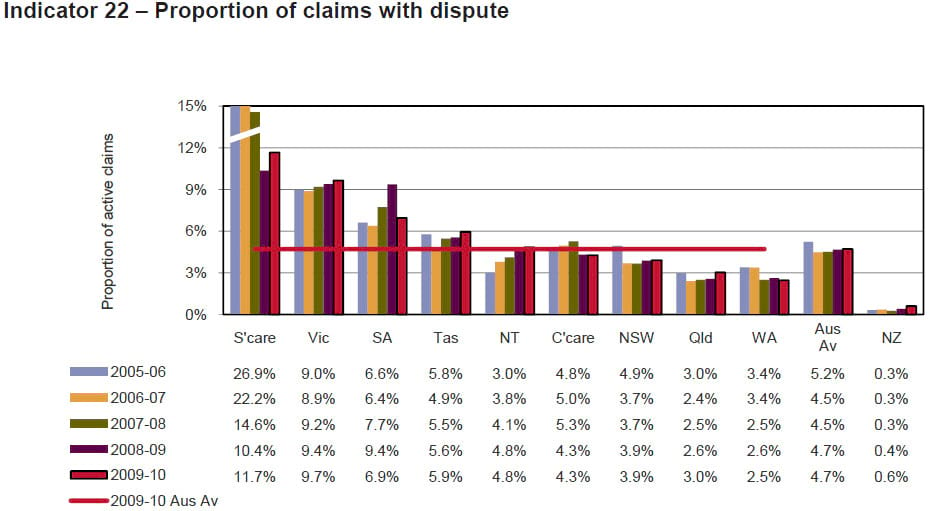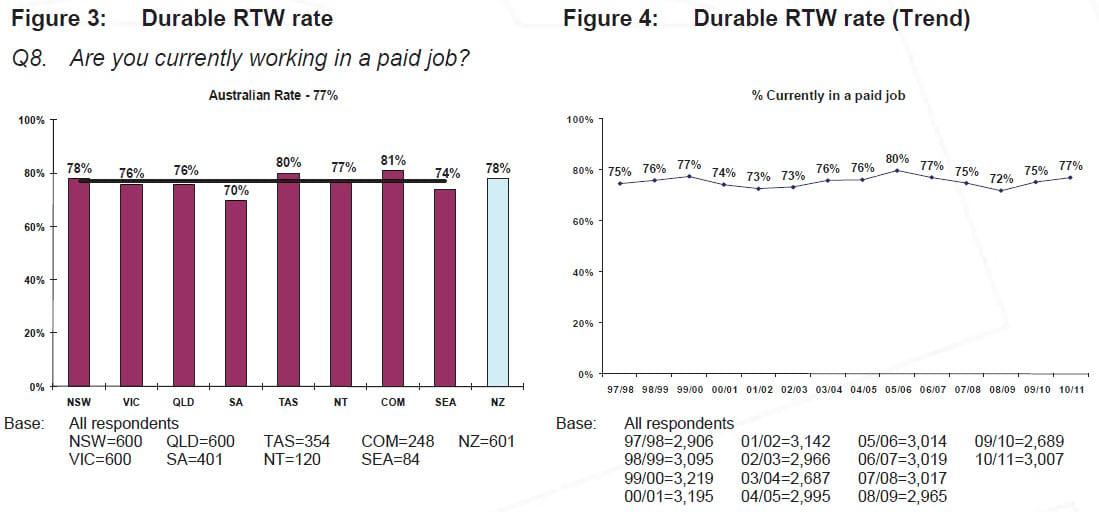Consider the alternative: Part 8 - Northern Territory

New to this series on the use of dispute resolution in workers' compensation disputes? Previous articles in this series include:
- Part 1 – An Introduction to Alternative Dispute Resolution
- Part 2 – What makes a good workers' comp system with Nerida Wallace, Principal of Transformation Management
- Part 3 – Victoria
- Part 4 – New South Wales with Sian Leathem, Registrar of the NSW Workers Compensation Commission
- Part 5 - Queensland with Elizabeth Woods, CEO of Q-COMP
- Part 6 - Western Australia with WorkCover WA
- Part 7 - Tasmania with Stephen Carey, Chief Commissioner of the Tasmanian Workers Rehabilitation and Compensation Tribunal
WORKERS COMPENSATION IN NORTHERN TERRITORY BY THE NUMBERS
Disputation Rate

Data taken from Workplace Relations Minister's Council Comparative Performance Monitoring Report (October 2011) (p. 38)
NT’s disputation rate had been climbing steadily 2005-06 through 2008-09. The 2009-10 rate of 4.8% was identical to last year, and marginally above the national average of 4.7%
Durable RTW Rate

Table from Heads of Workers' Compensation Authorities RTW Monitor 2010/11 (p. 2)
NT’s 2009-10 Durable RTW rate of 77% was third behind Tasmania and Queensland out of all reported Australian States and Territories, and higher than the national average of 75%.
THE NT MODEL
The NT model is two-tiered, comprising compulsory mediation and (if mediation fails), litigation in the Work Health Court (an arm of the NT Magistrates Court).
According to NT WorkSafe, “A pre condition to taking a dispute to the Work Health Court is mandatory mediation.”
Mediation
The mediation conference is a standard process. NT WorkSafe says that “the objective of mediation is to attempt to resolve disputes through exchange of documents and discussion with the parties.” This is the stage where the parties can control the settlement of the issue, as such, legal representation is not allowed without the express consent of the mediator.
Although the resolution rates for the NT are not covered in the Comparative Performance Monitoring Report, there is a fairly short timeline at least up to the end of mediation:
- NT WorkSafe must appoint a mediator within 7 days of receiving a claim.
- Mediation must finish within 21 days of that mediator being appointed.
- If not satisfied with the outcome of mediation, a party may apply to the Work Health Court within 28 days of the mediation.
According to NT WorkSafe, around 45% proceed to Court.
HOW THEY ARE MAKING IT BETTER
Greater involvement of insurers
Back in Part 2 of our series, Nerida Wallace said that “the more enlightened workers’ compensation administrators” encourage insurers “to improve their game". According to NT WorkSafe there have been a number of recent agreed changes that aim to improve the way insurers interact with the process, and manage a claim internally. These include:
- The requirement for all representatives of insurers to attend a mediation conference with appropriate decision making authority and participate with a desire to resolve the dispute.
- Encouraging speedy resolution by requiring insurers to better investigate medical or factual issues before taking action to suspend or reduce payments.
- Encourage better decision making and facilitate greater claimant understanding by requiring insurer to have an internal dispute resolution process. While access to this process is optional for claimants, it is attractive because it requires a 5 day response time from insurers.
Constant improvement of mediators and the process
NT WorkSafe also says that it is committed to ongoing improvements in terms of the efficiency and effectiveness of the process:
- Mediators are required to achieve national accreditation.
- Requiring provision of better information to claimants at the time of the claim and at relevant trigger points during the claim.
- Initiating service standards around dealing with requests and inquiries from claimants.
System reform
The NT is the latest jurisdiction in Australia to propose changes to its Workers' Compensation system. According to NTWorkSafe, the Workers Rehabilitation and Compensation Legislation Amendment Bill 2011 "reflects Government's commitment to ensuring the fair and effective operation of the Northern Territory Workers Compensation Scheme, while balancing the interest of all stakeholders."
The proposed changes include:
- allowing access to compensation by workers injured in Australia but who reside overseas; and
- providing quicker and fairer access to compensation for older workers who are injured
The NT government is open to submissions from the public and other interested parties up to 20 January 2012.
THE BOTTOM LINE
Without resolution rate data it is difficult to gauge how efficiently the system is operating. However, the changes to the way insurers operate and interact with the process along with raising standards of claimant service are encouraging signs that NT is dedicated to dispute resolution as a tool for delivering positive workers' compensation outcomes.

